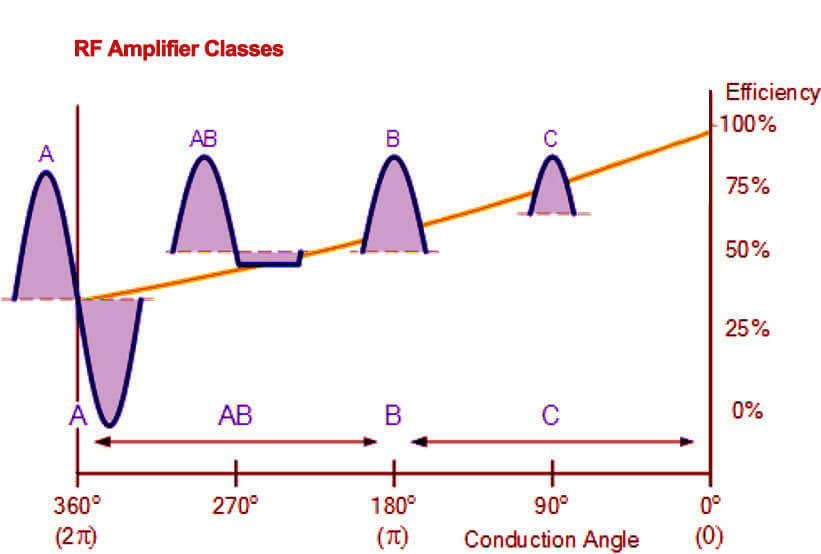What does an RF power amplifier do?
RF power amplifier is considered to be an essential device of the RF and microwave industries that converts low-power radio frequency signals into a higher frequency. In this article, we'll have a comprehensive cognition of RF and microwave power amplifier.
RF Power Amplifier Concept
RF power amplifier is an important part of all kinds of wireless transmitters. In the front-end circuit of the transmitter, the power of the RF signal generated by the modulation oscillator circuit is very small, and it needs to go through a series of amplification - buffer stage, intermediate amplification stage and final power amplifier stage. After enough RF power is obtained, it can be fed to the antenna and radiated. In order to obtain a sufficiently large RF output power, a RF power amplifier must be applied. After the modulator generates the radio frequency signal, the radio frequency modulated signal is amplified to sufficient power by the radio frequency amplifier, and then transmitted by the antenna through the matching network.
RF power amplifiers are electronic circuits that comprehensively consider issues such as output power, excitation level, power consumption, distortion, efficiency, size and weight. In the transmitting system, the output power of the RF power amplifier can be as small as mW and as large as several kW, but this refers to the output power of the final power amplifier. In order to achieve high power output, the last stage must have a sufficiently high excitation power level.
RF Amplifier Classes
The operating frequency of the RF power amplifier is very high, but the relative frequency band is narrow, and the radio frequency power amplifier generally adopts the frequency selective network as the load loop. The RF high power amplifier can be divided into three working states: A, B, and C according to the current conduction angle. The conduction angle of class A amplifier current is 360 degree, which is suitable for small-signal low power amplification. The conduction angle of class B amplifier current is equal to 180 degree, and the conduction angle of class C amplifier current is less than 180 degree. Both Class B and Class C are suitable for high-power working states, and the output power and efficiency of Class C working state are the highest among the three working states. Most of the RF power amplifiers work in class C, but the current waveform of the class C amplifier is too distorted, and can only be used to amplify the resonant power using a tuned circuit as a load. Due to the filtering capability of the tuned circuit, the loop current and voltage are still close to sinusoidal waveforms with little distortion.

Learn More: Class of Power Amplifiers
Solid State Power Amplifier Function
The function of the rf amplifier is to amplify the input content and output it. What is input and output, what we call a "signal", is often expressed as voltage or power. For a "system" like an amplifier, its "contribution" is to raise what it "absorbs" to a certain level and "output" it to the outside. If the amplifier can have good performance, then it can contribute more, which reflects its own "value". If there is a certain problem with the amplifier, then after starting to work or working for a period of time, not only can it not provide any "contribution", but there may be some unexpected "oscillation". This "oscillation" is catastrophic both to the outside and to the amplifier itself.
Learn More: What are RF amplifiers used for?
High Power Amplifier Technical Specification
The main technical indicators of RF power amplifiers are output power and efficiency. How to improve output power and efficiency is the core of the design goals of RF power amplifiers. Usually in the RF power amplifier, the fundamental frequency or a certain harmonic can be selected by the LC resonant circuit to achieve undistorted amplification. In addition to this, the harmonic components in the output should be as small as possible to avoid interference with other channels.
A detailed description of requirements is given below.
1. Gain
This is the ratio between input and output and represents the contribution of the amplifier. A good microwave amplifier should contribute as much "output" as possible within its "capacity".
2. Operating frequency
This represents the ability of the amplifier to carry signals of different frequencies.
3. Operating bandwidth
This determines how far the amplifier can "contribute". For a narrowband amplifier, even if there is no problem with its own design, its contribution may be limited.
4. Stability
Every transistor has a potential "region of instability". The "design" of the amplifier needs to eliminate these potential instabilities. There are two types of amplifier stability, potential instability and absolute stability. The former may be unstable under certain conditions and circumstances, while the latter is guaranteed to remain stable under any circumstances. The issue of stability is important because instability means “oscillation”, where the amplifier not only affects itself, but also outputs instability.
5. Maximum output power
This parameter determines the "capacity" of the amplifier. For "big systems", it is desirable to output more power at the expense of a certain gain.
6. Efficiency
Amplifiers must consume a certain amount of "energy" and also achieve a certain "contribution". The ratio of its contribution to consumption is the efficiency of the amplifier. If it can contribute more and consume less, it is a good amplifier.
7. Linearity
Linearity characterizes the correct response of the amplifier to a large number of inputs. Deterioration in linearity means that the amplifier will "distort" or "twist" the input in a state of excess input. A good amplifier should not exhibit this "malformed" quality.



![[This week's main recommended inventory] 6-18GHz Full-Band RF Power Amplifier Modules](https://cdn.keylinkwireless.com/images/article/8cd23e95-decf-4488-be99-f271b5c24c07.jpg)


